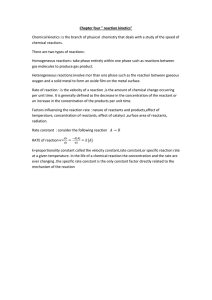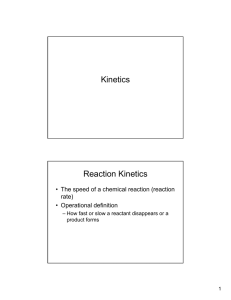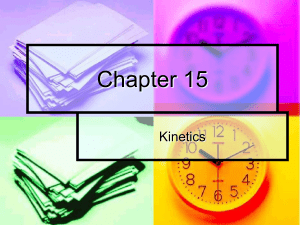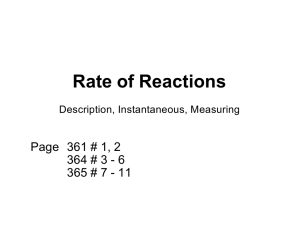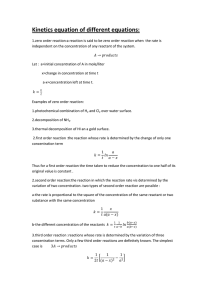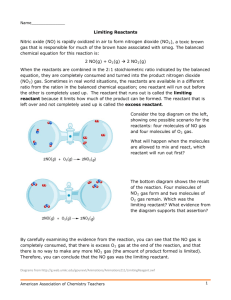Chapter 16 Kinetics
advertisement
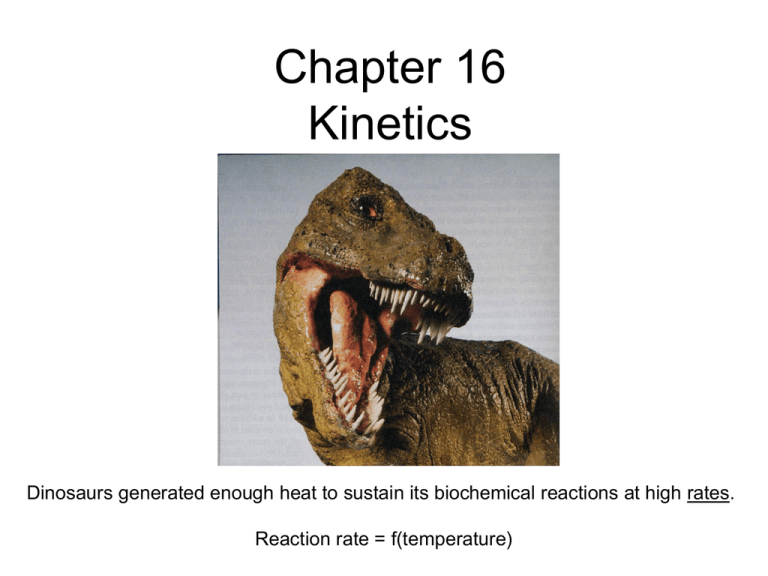
Chapter 16 Kinetics Dinosaurs generated enough heat to sustain its biochemical reactions at high rates. Reaction rate = f(temperature) What is chemical kinetics? Deals with the speed (rate) of a chemical reaction and its reaction mechanism. Describes the change in concentration as a function of time. Qualitatively…… Quantitatively…… Section 16.1: Factors that influence reaction rate Each specific reaction has its own characteristic reaction rate. We can control 4 factors that affect the rate of a given reaction: • Concentration of reactants • Physical state of reactants • Temperature of reaction • Presence of a catalyst Section 16.1: Factors that influence reaction rate (1) Concentration – Molecules must collide in order to react. The reaction rate changes throughout the course of a reaction. Section 16.1: Factors that influence reaction rate (2) Physical state of reactants – Molecules must collide in order to react. Reactants in same physical state random thermal motion brings them into contact Reactants in different physical states contact between reactants occurs only at the interface between the phases Example: reactants – orange + blue The more finely divided a solid or liquid reactant, the greater its surface area per unit volume More contact with other reactants Faster reaction. solid + aqueous (interface only) aqueous + aqueous Crushed coral versus whole coral. Section 16.1: Factors that influence reaction rate (3) Temperature of reaction – Molecules must collide with enough energy to react. Two aspects to this: (1) At higher temperatures, more collisions occur at a given time. (2) At higher temperatures, the energy of collisions is higher (K.E. of molecules is higher). Example: refrigeration to preserve food (4) Presence of a catalyst – A catalyst speeds up the reaction rate without being consumed (chemically reacting) in the reaction. Example: Biological catalysts Section 16.2: Expressing reaction rate quantitatively Rate – a change in some variable per unit of time Analogy with speed Reaction: A B reaction rate – the changes in concentrations of reactants or products per unit time Reactant concentrations decrease, while product concentrations increase. Reaction: A B Section 16.2: Expressing reaction rate quantitatively In most reactions, not only the concentration changes, but the reaction rate also changes. Therefore, we can define three reaction rates: Average reaction rate – how fast the concentration changes over the entire time period Instantaneous reaction rate – the reaction rate at an instant in time Initial reaction rate – the instantaneous rate at the moment the reactants are mixed Example: Reaction involved in the decrease of photochemical smog (ethylene + ozone) Reaction rate (rate of decrease of reactants): Section 16.2: Expressing reaction rate quantitatively Average reaction rate – how fast the concentration changes over the entire time period Instantaneous reaction rate – the reaction rate at an instant in time Initial reaction rate – the instantaneous rate the moment the reactants are mixed (slope of line that is tangent to the curve at t = 0) Section 16.2: Expressing reaction rate quantitatively Rates for reactants and products General formula: General equation: (a, b, c, d coefficients) Section 16.2: Expressing reaction rate quantitatively (a, b, c, d coefficients) General formula: General equation: (1) Express the rate in terms of changes in [H2], [O2], and [H2O] with time. (2) When [O2] is decreasing at 0.23 mol/L sec, at what rate is [H2O] increasing? 2 N2O5 (g) 4 NO2 (g) + O2 (g) (3) When [N2O5] is decreasing at 0.95 mol/L sec, at what rate is [NO2] increasing? 2 N2O5 (g) 2 NO2 (g) + N2O3 (g) + 3 O2 (g) (4) When [O2] is increasing at 0.54 mol/L sec, at what rate is [N2O5] decreasing? Section 16.3: Rate laws Experimentally determined not determined from reaction stoichiometry General reaction: aA + bB + … cC + dD + … Rate law: rate = k[A]m[B]n… where [A] and [B] are concentrations of reactants A and B k is the rate law constant – specific for a given reaction at a given temperature m and n are the reaction orders – defines how the rate is affected by reactant concentration Example: Specific reaction, specific temperature Rate law constant CH3COOCH2CH3 (ester) + H2O CH3COOH + CH3CH2OH Reaction orders – m and n = rate change / concentration change Examples: If the rate doubles when [A] doubles [A]1 and m = 1 If the rate quadruples when [B] doubles [B]2 and n = 2 If the rate does not change when [A] doubles [A]0 and m = 0 Section 16.3: Rate laws All terms in the rate law (rate = k[A]m[B]n….) must be determined experimentally. [A] and [B] measured and rate, rate constant (k), reaction orders (m, n) are deduced from these measurements. Measuring rates – many methods: (1) Conductometric methods – used when a nonionic reactant forms ionic products Example: (CH3)3C–Br (l) + H2O (l) (CH3)3C–OH (l) + H+ (aq) + Br- (aq) (2) Manometric methods – used when a reaction involves a change in the number of moles of a gaseous reactant or product reaction rate determined by the change in pressure over time Example: Zn (s) + 2 CH3COOH (aq) Zn2+ (aq) + 2 CH3COO- (aq) + H2 (g) Section 16.3: Rate laws (3) Spectrometric methods – used when one of the reactants of products absorbs (or emits) certain wavelengths of light Transmittance Example: NO (g, colorless) + 2 O3 (g, colorless) O2 (g, colorless) + NO2 (g, brown) Lightout Transmittance = Lightin Lightin Lightout NO2 Light Source Transparent Reaction Cell Light Detector Section 16.3: Rate laws (4) Direct chemical methods – used for reactions that can be easily slowed or stopped Example: Measure respiration rate by killing bacteria with HgCl2 to stop respiration. Respiration: O2 + CH2O CO2 + energy BOD bottle (Biological Oxygen Demand) • Measure O2 concentration at t=0 and t=24 hrs. • Change in O2 concentration = O2 (t=0) – O2 (t=24 hrs) • Respiration rate = change in O2 concentration time (24 hours) Section 16.3: Rate laws Determining Reaction Order First, some terminology………individual reaction order vs. overall reaction order Example: 2 NO (g) + 2 H2 (g) N2 (g) + 2 H2O (g) Rate = k[NO]2[H2] Individual: Reaction is second order with respect to NO and first order with respect to H2. Overall: Reaction is third order overall (sum of individual reaction orders). Rate = k[NO][O3] Rate = k[(CH3)3CBr][H2O]0 Rate = k[CHCl3][Cl2]1/2 *A zero order reaction order means that the reaction does not depend on the concentration of that reactant. Section 16.3: Rate laws Determining Reaction Order We have been determining reaction orders from a known rate law (i.e. Rate = k[NO][O3]) When the rate law is not known, use data from a series of experiments with different reactant concentrations to determine initial reaction rates. Change one reactant concentration, while keeping the other constant. Reaction is what order with respect to O2? With respect to NO? Overall? Section 16.3: Rate laws Determining Reaction Order We have been determining reaction orders from a known rate law (i.e. Rate = k[NO][O3]) When the rate law is not known, use data from a series of experiments with different reactant concentrations to determine initial reaction rates. Change one reactant concentration, while keeping the other constant. Reaction is what order with respect to O2? Double O2, double reaction rate: 1st order w.r.t O2 *reaction order = rate change / concentration change* Section 16.3: Rate laws Determining Reaction Order We have been determining reaction orders from a known rate law (i.e. Rate = k[NO][O3]) When the rate law is not known, use data from a series of experiments with different reactant concentrations to determine initial reaction rates. Change one reactant concentration, while keeping the other constant. Reaction is what order with respect to NO? Double NO, quadruple reaction rate: 2nd order w.r.t NO *reaction order = rate change / concentration change* Section 16.3: Rate laws Determining the Rate Constant Simply, solve for k. Rate law: rate = k[O2][NO]2 What is k for this reaction? Section 16.4: Integrated rate laws So far, we have not considered the time factor in the rate law equations. Rate = k[O2][NO]2 This equation says what the rate will be when [O2] is X and [NO] is Y, but does not tell use how long it will take for X moles of [NO] to be used up (for example). Integrated rate laws – consider the time factor and are derived from equations we have already seen using calculus Rate = k[A] For reaction: A B Magic Section 16.4: Integrated rate laws Example: At 1000 ºC, cyclobutane (C4H8) decomposes in a first-order reaction, with The very high rate constant of 87 s-1, to two molecules of ethylene (C2H4). If the initial cyclobutane concentration is 2.00 M, what is the concentration after 0.010 s? What fraction of cyclobutane has decomposed in this time? At 25 ºC, hydrogen iodide breaks down very slowly to hydrogen and iodine: rate = k[HI]2 The rate constant at 25 ºC is 2.4 x 10-21 L/mol sec. If 0.0100 mol of HI(g) is placed in a 1.0 L container, how long will it take for the concentration of HI to reach 0.00900 mol/L? Section 16.1 to 16.4: Solving Rate Problems – A Summary Q: What is the average, instantaneous, or initial reaction rate? Q: If a reactant/product is increasing/decreasing at some rate X, what is the rate of increase/decrease of some other reactant/product? Use concentration versus time data in either a Table or a Graph to calculate each. *Stoichiometry-based* (a, b, c, d coefficients) If the rate law (i.e. rate = k[A]2[B]) is known: ∆rate ∆concentration If given a rate, can solve for k. Reaction order (m, n) = If the rate law is not known, but you have [reactant] and initial rate data: Use data to find reaction orders for each reactant, then solve for k. Questions related to rate laws aA + bB + … cC + dD + … Rate law: Rate = k[A]m[B]n… *Use experimental data* *NOT stoichiometry* Q: • If the [A] doubles what will happen to the reaction rate? • To quadruple the reaction rate, how would you need to change [A]? • What is reaction order w.r.t. [A]? • What is overall reaction order if the rate law is ‘rate = k[A]2[B]’? • What is k for this reaction? No rate law, no initial reaction rates. Have [A] vs. time data. Trial-and-error graphical plotting time Q: • What is the [A] after x time? • How long will it take for [A] to reach X mol/L? Integrated rate laws Section 16.4: Integrated rate laws (continued) What if you have concentration and time data, but do NOT have the rate law (rate = k[A]m[B]n…) or the initial rate data? Trial-and-error graphical plotting For zero-order reactions: For first-order reactions: For second-order reactions: Section 16.4: Integrated rate laws (continued) Trial-and-error graphical plotting (Ocean Acidification!!!) Kinetics of Coral Dissolution Temp1 Temp2 2 1.8 Mass loss (g) 1.6 1.4 1.2 1 0.8 0.6 0.4 0.2 0 0 1 2 3 4 Time (Days) 5 6 7 Does coral dissolution follow zero-order kinetics? Kinetics of Coral Dissolution Temp1 Temp2 2 1.8 1.6 1.2 1 0.8 0.6 0.4 0.2 0 0 1 2 3 4 Time (Days) 5 6 7 Kinetics of Coral Dissolution Temp1 Does coral dissolution follow first-order kinetics? Temp2 Linear (Temp2) Linear (Temp1) 2 y = -0.4x + 0.6931 R2 = 1 1 ln (Mass Loss) Mass loss (g) 1.4 0 -1 -2 -3 0 1 2 3 4 y = -0.9x + 0.6931 R2 = 1 -4 -5 -6 Time (Days) 5 6 7 8 Kinetics of Coral Dissolution Does coral dissolution follow second-order kinetics? Temp1 Temp2 300 1 / Mass Loss 250 200 150 100 50 0 0 1 2 3 4 5 6 7 Time (Days) If coral dissolution followed first-order kinetics, what would that tell you about the dependence of the overall reaction rate of CaCO3 dissolution? (What does the rate depend on?) 8 Section 16.4: Integrated rate laws (continued) Example #2: Trial-and-error graphical plotting Section 16.4: Integrated rate laws (continued) Half-life (t1/2) It is the time required for a reactant concentration to reach half of its initial value. Applies to first-order reactions only independent of the starting concentration (In other words, if independent of starting concentration the t1/2 is independent of the number of other particles present) t1/2 = 0.693 / k Section 16.4: Integrated rate laws (continued) Radioactive decay – a common application of half-life (t1/2) Carbon-14 t1/2 = 5568 yrs How old is the Ice Man? Found in 1991 in the Alps. (~3,330 yrs old) Suggested Problems 16.39, 16.41, 16.43 [O2] (mol/L) (1) What is the average reaction rate, the initial reaction rate, and the instantaneous reaction rate for the reaction below given the data in the Table below? Time (min) [O2] (mol/L) 1.70 0 1.60 1.50 1 1.21 1.30 2 0.98 1.10 3 0.82 4 0.70 5 0.62 6 0.55 0.90 0.70 0.50 0 2 Time (Minutes) 4 6 (2) For the same reaction (above), how would the reaction rate change if you doubled the H2 concentration? How would you need to change the O2 concentration if you wanted to quadruple the reaction rate? (3) If you know that the rate law for the reaction shown below is rate = k[C2H4]2[O3], then if you doubled the [O3], how would the reaction rate change? How would you need to Change the [C2H4] to quadruple the rxn rate? Suggested Problems (Continued) (4) At 50 ºC, H2Cl2 breaks down into to H2 and Cl2 gases: rate = k[H2Cl2]2 The rate constant 1.8 x 10-2 L/mol sec. If 0.40 mol of H2Cl2 is placed in a 2.5 L container, how long will it take for the concentration of H2Cl2 to reach 0.25 mol/L? (5) At 50 ºC, C4H8 decomposes. The rate law is rate = k[C4H8]. If the concentration of cyclobutane is 0.80 mol/L after 20 minutes, what the the rate constant (k) at this temperature? The initial concentration of cyclobutane is 1.38 mol/L. (6) At 700 ºC, H2S gas breaks down into to diatomic hydrogen and sulfur gases. The rate = k[H2S]0 If the rate constant is 9.30 x 10-8 mol/L sec and the initial concentration of H2S gas is 0.18 mol/L, what will be the concentration of this gas 1 minute after the reaction is started? Section 16.4: Half-life (continued) Half-life t1/2 = 0.693 / k 16.43 In a first-order decomposition reaction, 50.0% of a compound decomposes in 10.5 minutes. (a) What is the rate constant of the reaction? (b) How long does it take for 75 % of the compound to decompose? Suggested Problems 16.44, 16.45 Section 16.5: Effect of Temperature on Reaction Rate An increase of 10 ºC (or K) causes a doubling or tripling of the reaction rate. Q10 – the factor by which the reaction rate is accelerated by raising the temperature by 10 degrees (2 – 3) Expressed by relationship to the rate constant, k. Rate Law rate = k[A]m[B]n… Half-life t1/2 = 0.693 / k Integrated Rate Laws Q10 – the factor by which the reaction rate is accelerated by raising the temperature by 10 degrees (2 – 3) Metabolic rates – the rates at which organisms use energy and materials The fundamental rate of biology (it comes down to biochemistry) Universal temperature dependence (UTD) of biological processes “Despite a hundred years of research, ecology has little in the way of universal laws of gravity and thermodynamics in physics or the Mendelian laws of inheritance in biology. Is ecology really devoid of universal laws?” 2004, New Scientist 2001, Science, Volume 293 Back to Chemistry…… Section 16.5: Effect of Temperature on a Chemical Reaction Rate Arrhenius equation (Svante Arrhenius) where A is the frequency factor (Next Section 16.6) T is the absolute temperature (*Must be in units of Kelvins) R is the Universal Gas Constant (8.31447 J/mol K) Ea is the activation energy (the minimum energy the molecules must have to react) Using this equation to find Ea from experimental data… First, the math Section 16.5: Effect of Temperature on Reaction Rate The decomposition of HBr has rate constants of 1.37 x 10-11 L/mol s at 350 K and 2.43 x 10-9 L/mol s at 450 K. Find Ea. Practice problem for you: Find Ea for the reaction of an ester with water using the following data from a kinetics experiment. Section 16.6: Effect of Concentration on Reaction Rate Collision Theory – Reactant particles (atoms, molecules, and ions) must collide with each other in order to react. Therefore, the # of collisions per time puts an upper limit on how fast a reaction can take place. Explains several things: (1) Why reactant concentrations are multiplied together in the rate law A + B products Rate Law rate = k[A]m[B]n… Section 16.6: Effect of Concentration on Reaction Rate (2) How temperature affects the rate In most collisions, the molecules rebound without reacting. Every reaction has an energy threshold that colliding molecules must exceed in order to react. This minimum energy threshold is called the activation energy (Ea). Only collisions with E > Ea will react. Temperature rise increases the number of collisions with enough energy to exceed Ea. Section 16.6: Effect of Concentration on Reaction Rate (3) the influence molecular structure has on rate In addition to colliding, and colliding with enough energy, molecules must also collide so that the reacting atoms make contact. Arrhenius equation (Svante Arrhenius) The effect of molecular orientation is contained in the term A (frequency factor) A = pZ Z collision frequency p orientation probability (effectively oriented collisions / all possible collisions) Section 16.6: Effect of Concentration on Reaction Rate Collision Theory – Reactant particles (atoms, molecules, and ions) must collide with each other in order to react. Therefore, the # of collisions per time puts an upper limit on how fast a reaction can take place. Molecules must: (1) Collide (2) Collide with a certain minimum energy (Ea – activation energy) (3) Collide with the right orientation (the A term in Arrhenius equation) Does not explain: Why the activation energy is crucial How the activated molecules look Transition state theory – focuses on the high-energy species that form through an effective collision Suggested Problems 16.58 – 16.46, 16.72, 16.74, 16.77, 16.78, 16.82

